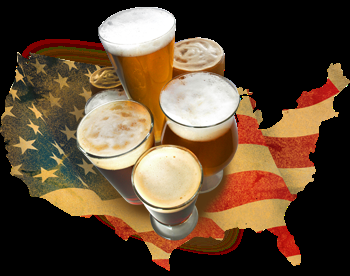
Just like any other industry, beer and its community are influenced.
Whether it's a flash in a pan fad or an honest to goodness trend, the ideas that impact people who create and consume beer can have lasting impacts. Then there are behemoths like the IPA - now making up roughly a quarter of craft beer sales - a style which just a few years ago seemed like a trend until it starting setting its own sub-trends with double IPAs and session IPAs and whatever India'd style you can dream of.
We're always looking for that Next Big Thing that's going to start something new, gazing into metaphorical crystal balls with hope of understanding what will next be poured into our glass. For Bart Watson, chief economist for the Brewers Association, that answer is lager:
Going booth to booth at the recent craft brewer pavilion at the National Grocers Association show, nearly every brewer had a great pilsner. Some were brands that have been around for a while, but there were plenty of new additions. Those new entries are combining with longer-term brands to create new excitement around pilsners.
Even if January sales of pilsners were up 56 percent in 2015 compared to the same month in 2014, the big question to ask isn't just whether "excitement" equates to groundswell of a trend, but also do American drinkers want this trend in the first place?
Among the reasons that IPAs have become such a hit for beer drinkers isn't for their simplicity, but rather their abrasiveness in the face of more even-keeled beers such as lagers. Wild or sour beer, long considered the current trend in beer, fits this bill perfectly, offering tart to mouth-puckering flavors once taboo for American palates.
But in reality, this should be no surprise. As the U.S. has embraced a stronger foodie culture, we now have appetites trained for strong flavors and intense experiences. Our search for greater flavor has impacted the spectrum of food, from herbs and spices to drinks to gum and entrees.
Ethnic food sales have been on the rise for years, especially among Millennials, the main target demographic for beer. At home, Americans keep an average of 40 spices in their cupboards and pantries. In 2015, food industry analysts expect even more focus on sour, sweet and salty. Or rather, characteristics to provide an explosion of flavor.
When it comes to our food, it's no longer about being safe, traditional or even-tempered. A culinary arms race is fighting for our attention, wallets and taste buds - and we like it.
Which is why when we talk about the growth of lagers, context is key. Even if the top-selling beers in America are (macro) lagers, the current wave of craft lagers more closely mirrors broader trends of the craft side of the industry. Breweries haven't been rushing to create well-balanced pilsners, they've been hopping up lagers to create India pale lagers (IPL), including Flying Dog, Ballast Point and Sam Adams. When it debuted in 2013, Sam Adams Double Agent IPL was the second highest-selling new craft beer brand in supermarkets.
Sierra Nevada has changed its seasonal lineup to include its "Beer Camp" series, starting in 2015 with Hoppy Lager, a dank, 7 percent ABV beer that straddles a line closer to a Lagunitas creation than refreshing hop-forward pilsner. But they also have that in the new, year-round Nooner Pilsner, which, according to their press release, is "easy-drinking yet full of spicy and floral hop flavor from the use of whole-cone European hop varietals."
Also to consider, Firestone Walker's Pivo Hoppy Pils and the wild success of Jack's Abby, which maxed out space in its original brewery within four years by making full-flavored lagers ... in the vein of ales from IPLs to Baltic porters and more.
But even more so, our evolved taste isn't a passing trend. When it comes to eating, people enjoy flavor-intense foods for a reason: they're pleasurable. When holding an expectation for food to provide unique flavors, it's worth asking if this psychological preference also passes along to the beer we drink. People come to craft seeking a specific experience they don't find from macro beer.
As a craft drinking community, we seek unique attributes from our beers, which is perhaps why we see the new wave of lagers not focusing on aspects of "clean" or "refreshing," but rather "hoppy" or "snappy." In fact, we are not only willing to spend more on beer to enjoy these characteristics, but we expect them, especially from craft beer.
The cultural meaning of a product impacts our perception, sometimes to the point where our mind forces us to perceive it as better. If we have been taught or told or experienced that lagers are boring and bland, especially in lieu of other, more intense, flavorful beers to be thought of as best, what is forcing us to about-face?
Which is not to say lagers can't offer us enjoyment or pleasure, especially for beer enthusiasts whose mouths have become worn out by the constant influx of enamel-striping, taste bud-badgering IPAs and other styles. Trends are often started by the experienced few, working their way to the masses who are ready for a change.
But if lagers are to be the Next Big Thing, perhaps we should focus on the evolution of the style to our patriotic palates, not necessarily the other way around.

+Bryan Roth
"Don't drink to get drunk. Drink to enjoy life." - Jack Kerouac

